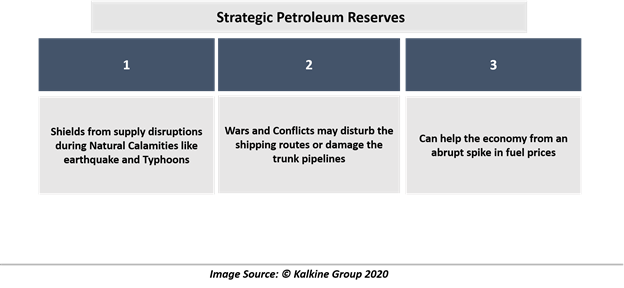What are Strategic Petroleum Reserves (SPR)?
Strategic Petroleum Reserves are natural or human-made structures to hold huge stockpiles of crude oil or natural gas and are of national strategic importance for any import-dependent country. The volumes stored in SPRs may range from a few days to months consumption in any event of supply disruption.
SPRs are constructed in underground natural caves or salt caverns. An abandoned oil or gas field is also used as storage and is economical as there exist reservoirs for hydrocarbons down below.
Why is SPR in the energy security policy of many countries?
Strategic Petroleum Reserves (SPR) is developed and maintained to ensure the supply of petroleum products in any event of supply disruption of crude oil or gas from the supplier country. It is a countermeasure which has been adopted by countries, that rely heavily on petroleum imports to meet their energy requirements.

The supply disruption may arise due to
- Force Majeure
A hurricane or a tornado may cause a halt in production as in case of offshore fields and production facilities. Earthquakes of high intensity can damage the group gathering facilities and other infrastructure. All these factors may impact the export potential of the company or country and can cause supply disruption.
- Conflicts or war
OPEC countries produce 40% of the total world’s production of crude oil. The relation between the countries due to fight for market capture give rise to tensions and eventually may turn into conflicts. Even the sea route, Strait of Hormuz is a hot zone due to the presence of multiple countries protecting their energy security.
Large volumes available in SPR may act as a tool to strategize and better position to absorb crude oil price shocks. Large inventories could be filled when prices are relatively lower and could be used when demand is on high side. Countries with large volumes available in their SPRs can also use it to rent out to countries with relatively lower or nil SPRs. Energy security or frequent price fluctuations in crude oil prices may drive import dependent countries to seek for the services of those who have larger SPRs.
Who holds most of the Global Strategic Petroleum Reserves?

U.S.A holds the highest storage capacity of the crude oil for emergency supplies. It has four underground huge salt caverns along the Gulf Coast to store its contingency supplies. The authorised capacity of 714 million barrels of the SPR can be sold to the market only through the presidential orders. With current year’s consumption (2020) projection of 18.23 million barrels per day, U.S.A holds roughly 39 days of supply, which during emergencies can last for a longer period time.
China ranks second when it comes to the strategic storage capacity of crude oils. It has never disclosed its installed capacity but has planned to boost the SPRs for the emergency supply for up to 90 days. China has significantly increased its import of US crude during the first half of 2020.
Based on the EIA report, China has 12 SPRs with a combined storage capacity of more than 300 million barrels of crude oil. With current consumption 13.91 of million barrels per day, the reserves could last more than 21 days.
Japan, without any domestic production, depends on 100% on crude oil and natural gas imports despite being 5th largest consumer of petroleum products. The government maintains the strategic reserves while the private players maintain the commercial stockpile.
As per the 2017 data, Japanese government holds 47.13 million kiloliters of crude oil which is sufficient for 126 days of domestic consumption. The government also maintains an inventory of LPG for 49 days of consumption.
India imports nearly 90% of its crude oil from suppliers from all corners of the world. To mitigate the supply disruption, India has recently inaugurated three underground cave SPRs with a total installed capacity of 5.33 Metric Million Tonnes.
In its next step towards energy security, India has started working to increase the number of SPRs and capacity by 6.5 Metric Million Tonnes. India has also inked a deal with U.S.A to store the strategic reserves in U.S.A. With the current consumption level of 4.04 million barrels per day, India’s current SPR will be enough for 9-10 days of domestic consumption. (September MOMR, OPEC data)
Australia is the largest exporter of LNG in the world but has to import crude oil to cover its domestic consumption. As of July 2020, Australia has 63 days of estimated IEA day of net import coverage stocks. These are the stocks available to the refineries or held by private parties.
Australian Government signed a deal with U.S.A to establish a first government owned strategic reserves for domestic fuel security. The deal is of A$ 94 million for the tenure of 10 years to store Australia’s crude in U.S.A stockpile.
 Please wait processing your request...
Please wait processing your request...